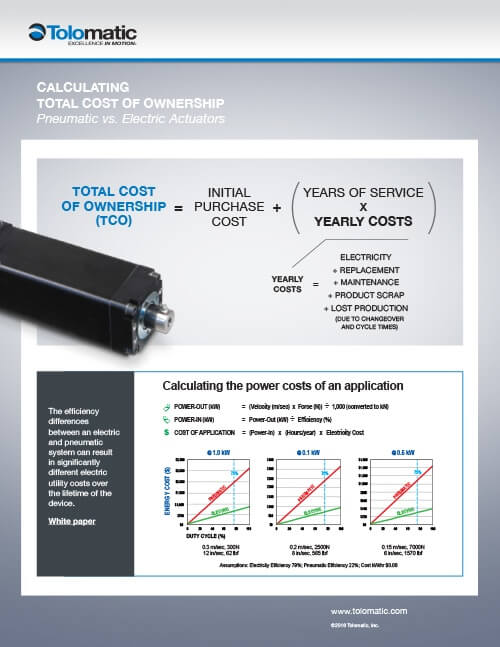Calculating total cost of linear actuators [INFOGRAPHIC]
By Tolomatic on March 22, 2016
 Not too long ago many machine designers only considered the purchase price of automation components, like linear actuators, when they analyzed cost. And manufacturing management only looked at acquisition cost when they considered investing in automation.
Not too long ago many machine designers only considered the purchase price of automation components, like linear actuators, when they analyzed cost. And manufacturing management only looked at acquisition cost when they considered investing in automation.
Now machine designers and manufacturers are using a more thorough approach to cost analysis. Rather than looking at purchase price alone, they are looking into the “total cost of ownership” of a component, machine or technology. It’s a business finance concept, used frequently when considering computer system upgrades.
An analysis of pneumatic cylinders versus electric linear actuators is eye-opening. Download our white paper, Electric actuators vs. pneumatic cylinders: A comparison based on total cost of ownership, for details.
What is total cost of ownership (TCO)
A basic formula for computing TCO for actuators is:
Total cost of ownership (TCO) =
initial purchase cost + (years of service X yearly costs)
Years of service can be based on experience with similar equipment under similar conditions or derived from its own calculation (such as the L10 life formula for bearings and other rolling elements.) The make-up of yearly costs for linear actuators includes electricity, replacement, maintenance, product scrap and lost production due to changeover and cycle times.
The cost of electricity
Of all these yearly costs the cost of electricity is the one that takes some figuring out. The basic formula is:
Electric Utility Cost of Application =
(Power-IN) X (Hours/year) X (Electricity Cost per kW-hr)
where
Power-IN((kW) = Power-OUT(kW) ÷ Efficiency (%)
and
Power-OUT(kW) = Velocity (m/sec) X Force (kN)
The efficiency of electrical systems is about 79% while for pneumatic systems it’s only 22% at best.
Electric versus pneumatic
The amount of electricity a device uses is directly related to the number of times it cycles. So duty cycle plays a large role in calculating the cost of electricity for a pneumatic cylinder or electric actuator.
Our new infographic shows the difference in electricity costs for three linear actuator applications with duty cycles ranging from to 0 to 100%. The greater efficiency of electric actuators makes an increasingly significant difference as duty cycle increases.
Because the trend is toward higher duty cycles that maximize machine utilization and plant productivity, electric linear actuators are becoming a popular choice for anyone looking at total cost.
Learn more
Download our white paper: Electric actuators vs. pneumatic cylinders: A comparison based on total cost of ownership.

 Ask an Engineer
Ask an Engineer